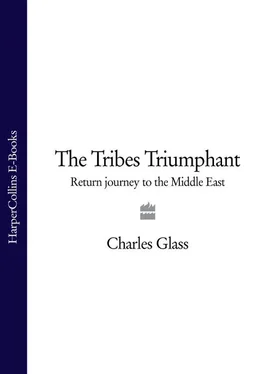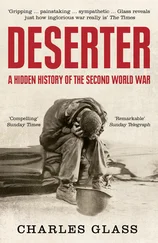We turned off the main Aqaba road at the King’s Highway to Wadi Musa and Petra. In the shade of a ridge, a lonely pool of snow resisted the change of season. Beyond were villages with abundant cypress, pine and olive trees on the slopes. A two-lane asphalt road floated along the hilltops into Rajif, a large village of flat-roofed houses, a white schoolhouse, a playground and as many vegetable shops as houses. We had to wait for old men in red keffiyehs to squeeze past us in the tightening streets. More open road took us into Taibit, splashed across the slopes of many jagged hills. There were two Taibits, the new town that had grown closer and closer to the windy summits, and Old Taibit – Taibit Zamen – near the base of a wadi. The old town’s earthen hovels with lovely arched entryways had occasional mounds on their level roofs and tiny gardens in open central courtyards. Old Taibit, nearer the water that coursed down the hills, stored rainfall in cisterns that fed their trees and crops. It was a place of stone, clay and mud. Above it loomed the new cement town, itself dwarfed by a new mosque. In the streets, old men paraded everywhere in cotton robes and keffiyehs or trousers and shirts. When I asked the driver why there were no children, he rubbed his thumb against his index finger and said, ‘No money.’
To reach Petra, the ancient Nabataean capital that the Swiss explorer Johann Ludwig Burkhardt rediscovered in 1812, we had to pass through New Petra. Here were the Movenpick, Petra Panorama, Marriott, Nabataean Castle and Grand View hotels, freshly built and doomed to bankruptcy. In 1973, this town with its shops, restaurants and amusement centres did not exist. Nor did the Visitors’ Centre, bookshop, souvenir kiosk and ticket office. Then, I had slept outside in a place called Nazal’s Camp, where I saw in the night sky every star that man had ever counted. And, counting them, I had fallen asleep.
If I fell in love with Petra as a graduate student on an Easter excursion, love went cold now. It was like revisiting an old mistress, her beauty diminished by cosmetic surgery rather than age. Petra then, six years after the June 1967 war and barely three years after the Black September civil war between Palestinian commandos and the Jordanian army, was an enchanted city of empty tombs and palaces, discovered but not desecrated. It was like no other city of antiquity – no fortifications, no encircling walls, no natural water source and no cramped streets. It was larger than other ancient cities, about 65,000 acres spread over rocky ravines, desert plain and mountains. The Nabataeans had lived in elaborate caves and freestanding palaces. They funnelled rainwater from the hills – a great natural flow collected at Petra’s base – and cut channels to carry water from Ain Musa, the Spring of Moses, to their commercial metropole. They relied on the narrow valleys, the towers of natural sandstone and their own mobile defences to protect them from marauders and invaders.
In 1973, Bedouin lived in a few of Petra’s higher caves. I met some of them and, like any other tourist, took pictures. They gave me coffee and talked politics. The only visitors disturbing their tranquillity, apart from me, were Jordanian schoolchildren on a day trip. The only people who demanded money were the young men who hired horses. They had told me – what did I know aged twenty-two? – that I was required to enter Petra on horseback. So it was that I had my first glimpse of Al-Khazaneh – the so-called Pharaoh’s Treasury – at the end of a long gorge called the Siq, on horseback. Burkhardt entered on a noble Bedouin steed, but mine was a nag who looked so hungry I should have carried her.
Jordan had used the interval of nearly thirty years between my two visits to effect ‘improvements’. At the Visitors’ Centre near the Bab Al Siq a ticket seller charged ten Jordanian dinars for entry. At a tollgate, I showed my ticket, as if in a cinema, and walked in. The horse hirers were still there, but government officials watched to guarantee they did not cheat the few foreign visitors. This time, I walked. The route was the same but the path had been paved and provided with little waste-baskets bearing the logo ‘Edico’. Workers in Edico uniforms swept the path, and signs in English explained everything. ‘Al Siq,’ the first read, ‘is 1207 metres long and 3 to 16 metres wide. It is a natural gorge of spectacular geological formation, which the Nabataeans widened in parts by carving out the rock …’ No one needed a sign to tell him the gorge was spectacular. It was like reading in the Louvre ‘Beautiful painting of a woman with an enigmatic smile by the Italian Leonardo da Vinci’.
I overtook a family that I assumed were Americans from the Midwest. The father carried a baby on his chest and wore a ‘J + B Scotch’ T-shirt, Nike trainers and a baseball cap. His wife and daughter licked ice creams and wore blue jeans. But they were speaking Arabic. In 1973, Jordanian men did not wear baseball caps or carry babies. Jordanian women – when in Jordan – wore long dresses. Petra and its indigenous visitors were adapting or assimilating to the new global empire as the Nabataeans had to Greece and Rome. I rushed ahead of them lest anything come between me and my first sight through the narrow cleft at the end of Al Siq.
The gorge opened and up shot a magnificent tomb, mountain-high, that said, ‘Stranger, beat this.’ Invaders coming to Petra by this route would have entered single file, there to be cut down one at a time by Nabataean archers on the plaza of their king’s mausoleum. It was a good place to die, overwhelming in its beauty and surprise. I did not die but the new Coca-Cola kiosk and souvenir stands were killing me. Tour guides were explaining, perhaps for the thousandth time, that the treasury, Al-Khazaneh, was never a storehouse of gold and jewels but the burial place of a king. They did not explain why Jordan had permitted the desecration of this once-solitary shrine.
I sat on a bench, listening to guides and tourists, and looked at the tomb. A headless eagle – defaced, no doubt, by iconoclasts of one monotheism or another – sat poised to soar from the perch on which Nabataean sculptors had placed him a century before the Crucifixion. Then I wandered among Petra’s palaces and tombs and theatres. In 1973, when I had slept out at Nazal’s Camp, Bedouin lived all over Petra. Like Nazal’s Camp, the Bedouin had been removed. No longer in their caves along the ridges, they lived miles away and sent their children into the ruins to beg from tourists. Some of them sold coloured rocks. ‘No, thank you,’ an American woman with legs larger than her trousers said to a little Bedouin girl. ‘I think the rocks should stay in this place.’ She also thought her money should stay in her handbag.
The children approached me. When I gave a dinar to one of the boys, his sister said I had to give another one to her. Six or seven years old, they were determined entrepreneurs. Another child, who said her name was Rima and looked about ten, gave me a stone of the same rosy stripes as the Treasury. In English, she asked if I preferred to see the Monastery or the Bedouin camp where her family lived. We came to a tea shop, whose proprietor tried to sell me silver jewellery. When I declined, he said, ‘For your wife.’ No wife. ‘For your secretary?’ He chased Rima away, perhaps resenting the competition, and gave me a glass of tea.
An American family on camels trotted behind a camel herder. Some Russians – father, mother, daughter – asked the tea vendor for directions to the Monastery. I walked on to an amphitheatre. A goat grazed near the stage on which the Nabataeans had thrilled to the tragedies of Greece. Other tourists, people like me, shooed the goat aside and took pictures of themselves. Rima and the other children tried to make them buy stones. I should not have come back. The driver, asleep in his car near the Bab Al Siq, woke and drove me to an indifferent lunch at a restaurant near the Turkish bath. He asked if I had enjoyed Petra. I didn’t answer.
Читать дальше












